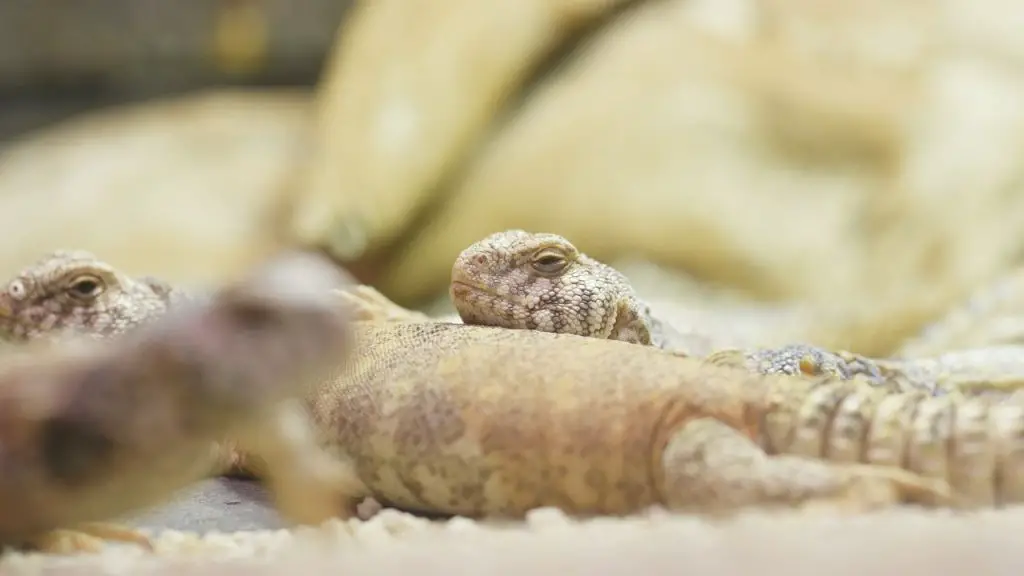How well do you know your pet uromastyx? I bet there are many things you don’t know about this lizard species aside from their basic care needs.
The fun facts to be discussed in this article will help you appreciate their makeup and ability to survive in an inhabitable environment like deserts.
The name uromastyx is their given scientific name. They belong to the agamid family, the same family with bearded dragons, clown agamas, and many other lizards.
Like every other pet lizard with common names, uromastyx is given the name ‘spiny tailed’. This name is inspired by their unique 10-30 rings of spiked scales covering their tails.
This species of lizards are found in hot, arid, and broken scrublands. They’re native to North Africa, the Middle East, South-Central Asia, and part of India. In each of these regions where they’re native, they have specific names which they are called.
Let’s find out more about them together.
Do Uromastyx Make Good Pets?

Yes, for many reasons, uromastyx make good pets for both experienced keepers and beginners. One of the unique qualities that make uromastyx good pets is that they’re docile instead of their natural environment.
Lizards from such harsh environments as deserts are supposed to be hot-tempered and dangerous. But uromastyx are calm and get acclimatized easily in captivity.
Uromastyx are easy to care for with simple husbandry requirements. They’re moderate in size and have a long lifespan of 20 years or even more.
When they’re still new, your pets may be shy and hide often, but once they’ve settled in, they love to be handled gently.
Although uromastyx aren’t common pets to come by, their varying beautiful colors make them one of the sought-after pet reptiles.
15 Uromastyx Facts
- Uromastyx go by different names.
- Uromastyx have a muscular body that will inflate to wedge themselves in burrows.
- About 20 species of uromastyx have been identified.
- Uromastyx can tolerate temperatures as high as 115 F even without water.
- Uromastyx major foods are fibrous plants.
- Uromastyx can change their body color based on temperature.
- Uromastyx are varying beautiful colors.
- Uromastyx are not fast growers.
- Uromastyx have strong muscular legs and claws for digging.
- While sleeping, uromastyx use their tails to wedge the burrow entrance to keep them safe.
- Uromastyx are day-active lizards.
- Uromastyx mate shortly after brumation.
- Uromastyx lay a large clutch of eggs.
- Every uromastyx species are different lizards in their genetic makeup.
- Uromastyx don’t need water.
Let’s talk about those Uros facts deeper!
1.) Uromastyx go by different names depending on the location where they are found. Among these names are dab lizards, mastigures, spiny-tailed, or Uros in short. They’re so-called spiny-tailed because of the spiked, ring scales that covered their tails.
This set of ring scales are sharp and can inflight injury if you run your fingers upward. Their tails are one of the things they would use in the wild to scare predators.
2.) Aside from using their tails to ward off predators, uromastyx have a muscular body that will inflate to wedge themselves in burrows such that they can’t be pulled out. This body inflation is another technique they use in the wild to stay alive.
3.) There have been many controversies on the actual number of uromastyx species. Some would say between 13-16. Other sources would put it to be 19-22.
Undoubtedly, there are many species of uromastyx. The confusion lies in that only a few species are kept in homes as pets. Most of the keepers of this species of lizards as pets are from the United States and Europe.
About 20 species of uromastyx have been identified.
4.) Inhabiting the hottest part of the earth, uromastyx can tolerate temperatures as high as 115 F even without water.
5.) As desert-dwelling lizards, uromastyx major foods are fibrous plants such as fat hen, spinach, Atriplex, and many others.
Eating these plants is where they get their water. Since there isn’t frequent rain in deserts coupled with the high salt content in desert soils, most of the desert plants, they eat also have high salt contents.
Even with these harsh conditions, uromastyx can retain water in their body for as long as they want. They’re able to archive this with the help of some special glands in their nostrils that help eliminate extra salt without eliminating water.
This is why in captivity, you will notice some whitish discharge from their nostrils.
6.) Uromastyx can change their body color in a bit to regulate their body temperature. This color change is more pronounced during cooler periods. They would become darker in order to absorb more heat from the sun and would go lighter if they get too hot.
7.) Uromastyx are known for their varying beautiful colors. Each uromastyx species has a distinctively unique body color that makes it different from other species.
The colors usually range from dark blue or green with yellow and orange pops to shades of tan and brown with yellow and orange markings. Whatever is the base color of the uromastyx species, the males appear more colorful than the females.
While the males are brightly colored, the females look dull in color. A typical example is the ornate species of uromastyx.
8.) Uromastyx of any species are not fast growers. They become adults within 3-4 years. Meanwhile, in other lizards, at the age of two, they’re already adults. As adults, they usually measure at least 35cm.
9.) In the wild, uromastyx live in rock crevices and in burrows they made. This explains the fact that uromastyx have strong muscular legs and claws that can dig burrows in the hard, rocky desert ground that they live.
10.) While sleeping in their burrows, uromastyx would use their tails to wedge the burrow entrance to keep them safe.
11.) Uromastyx are day-active lizards. In the wild, their routine includes basking in direct sunlight, eating some available wild plants, leaves, and flowers, resting in the shade of some of the plants they eat, and burrowing.
Since they’re diurnal lizards, they hardly sleep during the day except during brumation or if threatened by a predator.
12.) Uromastyx, like other reptile lizards, mate shortly after their annual brumation in March and April.
13.) Uromastyx lay a large clutch of eggs. Gravid females can lay between 10-22 eggs. Most uromastyx I have come across lay not less than 28 eggs.
14.) Every species and sub-species of uromastyx are different lizards in their genetic makeup. For this reason, uromastyx are not to be crossbred except proper research has been carried out on the mating species.
15.) Many breeders believe that pet uromastyx don’t need water. Because they don’t frequently come across water in the wild doesn’t mean they should not be given water in captivity.
Wrapping Up
Uromastyx is one exotic reptile that pet enthusiasts love to have as pets. Most homes in the United States and Europe have one or two wild animals as pets, of which uromastyx make the list.
Uromastyx are not ill-tempered, and the same genders of the same species can live together while still juveniles. Some breeders have success keeping them together when they are still babies till they get to juveniles.
Only that you would need a bigger and wider enclosure to allow enough space for roaming.
One thing you should have in mind is that uromastyx are hardy lizards, which is why they’re able to survive in deserts. Thus, don’t over pamper them with low temperatures in captivity.
